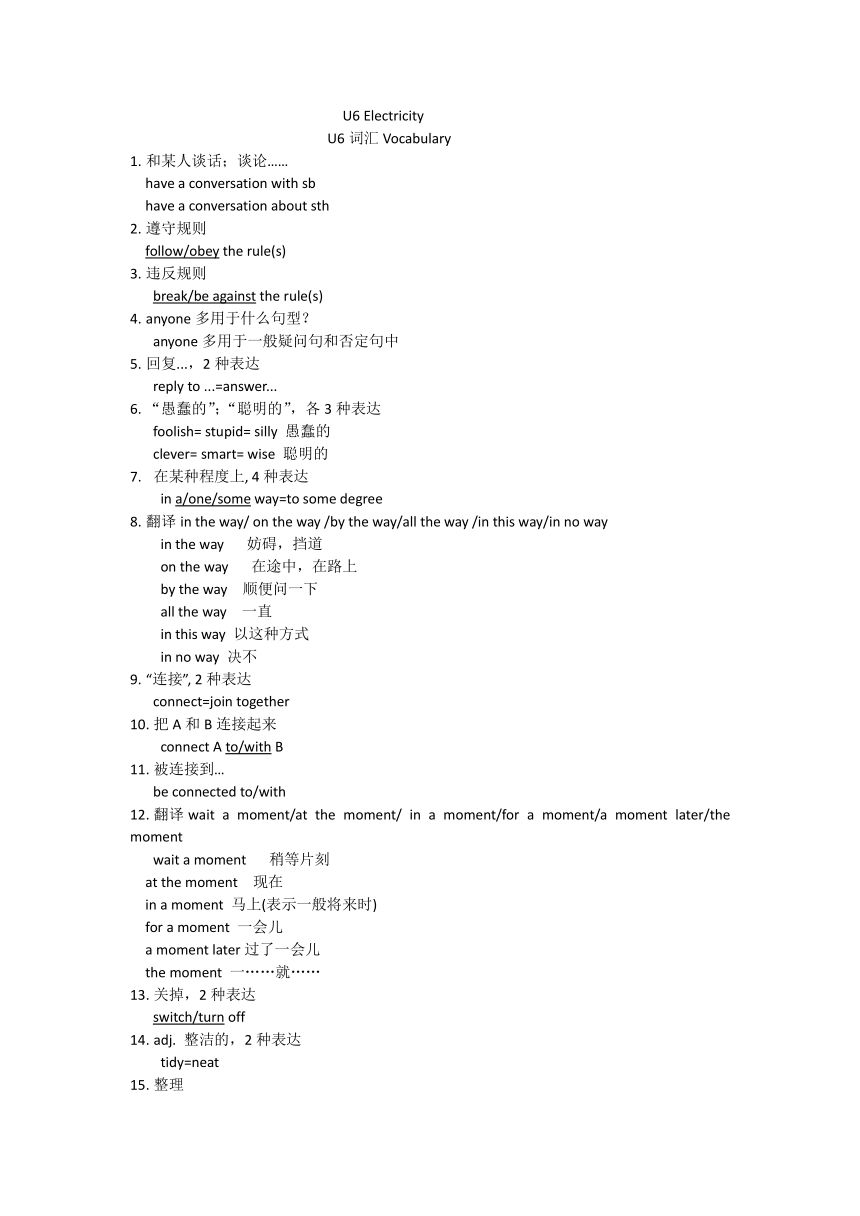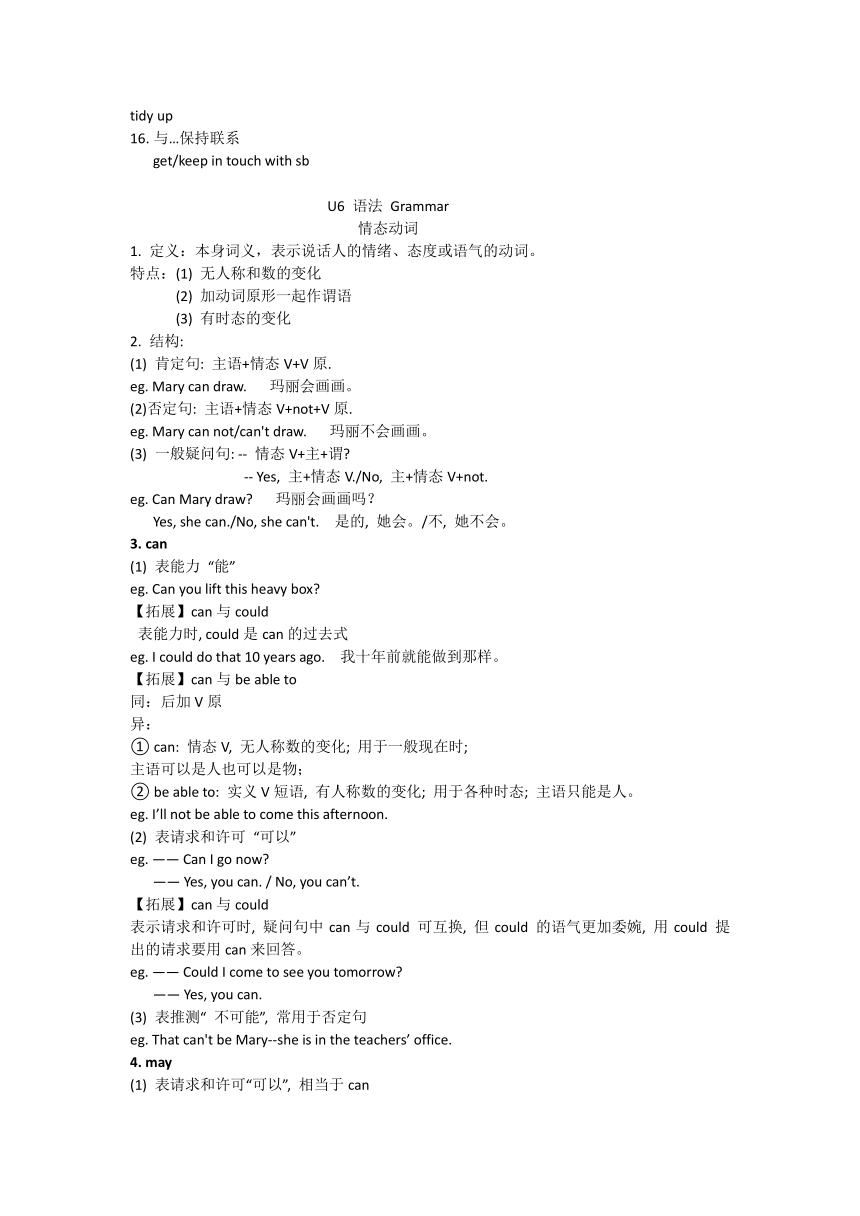Unit 6 Electricity 知识单 2023-2024学年牛津深圳版英语下册
文档属性
| 名称 | Unit 6 Electricity 知识单 2023-2024学年牛津深圳版英语下册 |  | |
| 格式 | docx | ||
| 文件大小 | 72.0KB | ||
| 资源类型 | 教案 | ||
| 版本资源 | 牛津深圳版 | ||
| 科目 | 英语 | ||
| 更新时间 | 2024-05-13 10:32:56 | ||
图片预览


文档简介
U6 Electricity
U6词汇Vocabulary
和某人谈话;谈论……
have a conversation with sb
have a conversation about sth
遵守规则
follow/obey the rule(s)
违反规则
break/be against the rule(s)
anyone多用于什么句型?
anyone多用于一般疑问句和否定句中
回复...,2种表达
reply to ...=answer...
“愚蠢的”;“聪明的”,各3种表达
foolish= stupid= silly 愚蠢的
clever= smart= wise 聪明的
在某种程度上, 4种表达
in a/one/some way=to some degree
翻译in the way/ on the way /by the way/all the way /in this way/in no way
in the way 妨碍,挡道
on the way 在途中,在路上
by the way 顺便问一下
all the way 一直
in this way 以这种方式
in no way 决不
“连接”, 2种表达
connect=join together
把A和B连接起来
connect A to/with B
被连接到…
be connected to/with
翻译wait a moment/at the moment/ in a moment/for a moment/a moment later/the moment
wait a moment 稍等片刻
at the moment 现在
in a moment 马上(表示一般将来时)
for a moment 一会儿
a moment later过了一会儿
the moment 一……就……
关掉,2种表达
switch/turn off
adj. 整洁的,2种表达
tidy=neat
整理
tidy up
与…保持联系
get/keep in touch with sb
U6 语法 Grammar
情态动词
1. 定义:本身词义,表示说话人的情绪、态度或语气的动词。
特点:(1) 无人称和数的变化
(2) 加动词原形一起作谓语
(3) 有时态的变化
2. 结构:
(1) 肯定句: 主语+情态V+V原.
eg. Mary can draw. 玛丽会画画。
(2)否定句: 主语+情态V+not+V原.
eg. Mary can not/can't draw. 玛丽不会画画。
(3) 一般疑问句: -- 情态V+主+谓
-- Yes, 主+情态V./No, 主+情态V+not.
eg. Can Mary draw 玛丽会画画吗?
Yes, she can./No, she can't. 是的, 她会。/不, 她不会。
3. can
(1) 表能力 “能”
eg. Can you lift this heavy box
【拓展】can与could
表能力时, could是can的过去式
eg. I could do that 10 years ago. 我十年前就能做到那样。
【拓展】can与be able to
同:后加V原
异:
① can: 情态V, 无人称数的变化; 用于一般现在时;
主语可以是人也可以是物;
② be able to: 实义V短语, 有人称数的变化; 用于各种时态; 主语只能是人。
eg. I’ll not be able to come this afternoon.
(2) 表请求和许可 “可以”
eg. —— Can I go now
—— Yes, you can. / No, you can’t.
【拓展】can与could
表示请求和许可时, 疑问句中can与could 可互换, 但could 的语气更加委婉, 用could 提出的请求要用can来回答。
eg. —— Could I come to see you tomorrow
—— Yes, you can.
(3) 表推测“ 不可能”, 常用于否定句
eg. That can't be Mary--she is in the teachers’ office.
4. may
(1) 表请求和许可“可以”, 相当于can
【注意】may构成的一般疑问句及其回答:
— May I ...
— Yes, you may / can.
— No, you may not / can’t /mustn’t. “不可以,禁止”
eg. —— May I take this book out of the room
—— Yes, you may/can.
No, you may not/can’t / mustn’t.
【拓展】may与might
表示请求许可时, might 的语气更加委婉
(2) 表推测“可能”, 常用于肯定句
eg. He may be very busy now.
【拓展】may与might
might是may的过去式, 表示对过去的推测;might所表示可能性比may低一些
eg. Your mother may /might not know the truth.
(3) 表祝愿,用于祈使句,
“May+主语+动词原形”
eg. May you succeed!
【拓展】maybe与may be
①may be: “可能是”,“情态动词+be”, 充当谓语成分
②maybe: “可能”,副词,充当状语
eg. You may be right.
Maybe you are right.
5. must
(1) 表命令“必须”
eg. You must do your homework first.
你必须先做作业。
【拓展】 must与have to
同:后加V原
【注意】
① must 的否定式为must not / mustn’t “禁止”
eg. You mustn’t smoke here.
你不许在这里吸烟。
② must 构成的一般疑问句及其回答:
— Must I ...
—Yes, you must.
— No, you needn’t./No, you don’t have to.
(2) 表示推测“一定”, 仅用于肯定句, 常指比较有把握的推测
eg. Jack and Dick must be twins. They look so much alike!
U6 写作 Writing
【话题】制定规则(班规,校规,家规)
【范文】
We must follow the school rules when we are at school. First, we should be polite to teachers and friendly to other students. Second, we must get to school on time. Third, we must wear school uniforms on weekdays. Fourth, we should help each other and we mustn’t fight with others. Also, we can’t bring mobile phones to school. What’s more, we must keep quiet in class and we must switch off the lights when we leave the classroom.
In a word, if all of us obey the rules, I think our school will be better and better.
我们在学校时必须遵守校规。首先,我们应该对老师有礼貌,对其他学生友好。第二,我们必须准时上学。第三,我们必须在工作日穿校服。第四,我们应该互相帮助,不能和别人打架。此外,我们不能把手机带到学校。更重要的是,我们在课堂上必须保持安静,离开教室时必须关灯。
总之,如果我们所有人都遵守规则,我想我们的学校会越来越好。
U6词汇Vocabulary
和某人谈话;谈论……
have a conversation with sb
have a conversation about sth
遵守规则
follow/obey the rule(s)
违反规则
break/be against the rule(s)
anyone多用于什么句型?
anyone多用于一般疑问句和否定句中
回复...,2种表达
reply to ...=answer...
“愚蠢的”;“聪明的”,各3种表达
foolish= stupid= silly 愚蠢的
clever= smart= wise 聪明的
在某种程度上, 4种表达
in a/one/some way=to some degree
翻译in the way/ on the way /by the way/all the way /in this way/in no way
in the way 妨碍,挡道
on the way 在途中,在路上
by the way 顺便问一下
all the way 一直
in this way 以这种方式
in no way 决不
“连接”, 2种表达
connect=join together
把A和B连接起来
connect A to/with B
被连接到…
be connected to/with
翻译wait a moment/at the moment/ in a moment/for a moment/a moment later/the moment
wait a moment 稍等片刻
at the moment 现在
in a moment 马上(表示一般将来时)
for a moment 一会儿
a moment later过了一会儿
the moment 一……就……
关掉,2种表达
switch/turn off
adj. 整洁的,2种表达
tidy=neat
整理
tidy up
与…保持联系
get/keep in touch with sb
U6 语法 Grammar
情态动词
1. 定义:本身词义,表示说话人的情绪、态度或语气的动词。
特点:(1) 无人称和数的变化
(2) 加动词原形一起作谓语
(3) 有时态的变化
2. 结构:
(1) 肯定句: 主语+情态V+V原.
eg. Mary can draw. 玛丽会画画。
(2)否定句: 主语+情态V+not+V原.
eg. Mary can not/can't draw. 玛丽不会画画。
(3) 一般疑问句: -- 情态V+主+谓
-- Yes, 主+情态V./No, 主+情态V+not.
eg. Can Mary draw 玛丽会画画吗?
Yes, she can./No, she can't. 是的, 她会。/不, 她不会。
3. can
(1) 表能力 “能”
eg. Can you lift this heavy box
【拓展】can与could
表能力时, could是can的过去式
eg. I could do that 10 years ago. 我十年前就能做到那样。
【拓展】can与be able to
同:后加V原
异:
① can: 情态V, 无人称数的变化; 用于一般现在时;
主语可以是人也可以是物;
② be able to: 实义V短语, 有人称数的变化; 用于各种时态; 主语只能是人。
eg. I’ll not be able to come this afternoon.
(2) 表请求和许可 “可以”
eg. —— Can I go now
—— Yes, you can. / No, you can’t.
【拓展】can与could
表示请求和许可时, 疑问句中can与could 可互换, 但could 的语气更加委婉, 用could 提出的请求要用can来回答。
eg. —— Could I come to see you tomorrow
—— Yes, you can.
(3) 表推测“ 不可能”, 常用于否定句
eg. That can't be Mary--she is in the teachers’ office.
4. may
(1) 表请求和许可“可以”, 相当于can
【注意】may构成的一般疑问句及其回答:
— May I ...
— Yes, you may / can.
— No, you may not / can’t /mustn’t. “不可以,禁止”
eg. —— May I take this book out of the room
—— Yes, you may/can.
No, you may not/can’t / mustn’t.
【拓展】may与might
表示请求许可时, might 的语气更加委婉
(2) 表推测“可能”, 常用于肯定句
eg. He may be very busy now.
【拓展】may与might
might是may的过去式, 表示对过去的推测;might所表示可能性比may低一些
eg. Your mother may /might not know the truth.
(3) 表祝愿,用于祈使句,
“May+主语+动词原形”
eg. May you succeed!
【拓展】maybe与may be
①may be: “可能是”,“情态动词+be”, 充当谓语成分
②maybe: “可能”,副词,充当状语
eg. You may be right.
Maybe you are right.
5. must
(1) 表命令“必须”
eg. You must do your homework first.
你必须先做作业。
【拓展】 must与have to
同:后加V原
【注意】
① must 的否定式为must not / mustn’t “禁止”
eg. You mustn’t smoke here.
你不许在这里吸烟。
② must 构成的一般疑问句及其回答:
— Must I ...
—Yes, you must.
— No, you needn’t./No, you don’t have to.
(2) 表示推测“一定”, 仅用于肯定句, 常指比较有把握的推测
eg. Jack and Dick must be twins. They look so much alike!
U6 写作 Writing
【话题】制定规则(班规,校规,家规)
【范文】
We must follow the school rules when we are at school. First, we should be polite to teachers and friendly to other students. Second, we must get to school on time. Third, we must wear school uniforms on weekdays. Fourth, we should help each other and we mustn’t fight with others. Also, we can’t bring mobile phones to school. What’s more, we must keep quiet in class and we must switch off the lights when we leave the classroom.
In a word, if all of us obey the rules, I think our school will be better and better.
我们在学校时必须遵守校规。首先,我们应该对老师有礼貌,对其他学生友好。第二,我们必须准时上学。第三,我们必须在工作日穿校服。第四,我们应该互相帮助,不能和别人打架。此外,我们不能把手机带到学校。更重要的是,我们在课堂上必须保持安静,离开教室时必须关灯。
总之,如果我们所有人都遵守规则,我想我们的学校会越来越好。
同课章节目录
